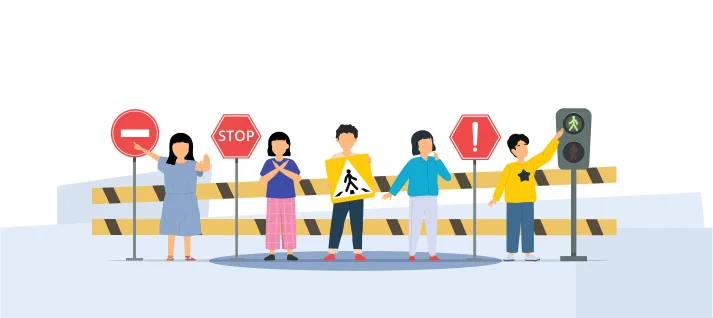Active vs Passive ADAS Systems
Modern automobiles are more than machines; they are intelligent road companions. With India's increasing traffic, erratic driving habits, and accident rate, advanced driver assistance systems (ADAS) are becoming essential rather than optional.
However, not all systems operate in the same manner. While some actively work to prevent collisions, others protect you in the case of one. Every Indian driver of today has to understand both active and passive safety.
This information may be just as crucial when selecting your next car as mileage or engine specifications. Let's look at the differences between active and passive ADAS and how they work.

Table of Contents
What are the differences between active and passive ADAS?
Passive safety and active safety are like two sides of the same coin.
-
Active safety systems in cars function like proactive bodyguards, detecting danger and taking action to avoid it.
-
Passive safety systems in cars function as your final line of defence, cushioning impact when an accident is unavoidable.
Both passive and active safety technologies are essential for keeping you and your loved ones safer on Indian roads, even if they operate differently.
Examples of passive safety systems
Passive safety systems in cars are your last line of defence when a collision happens. Key examples include:
-
Seatbelts: The first safety measure to protect passengers in the event of an accident or abrupt stop, seatbelts are required under Rule 125 of the Central Motor Vehicle Rules (CMVR).
-
Airbags: When a crash occurs, airbags inflate to cushion passengers and lessen injuries. Under the Ministry of Road and Transport and Highways (MoRTH) regulations, dual front airbags (driver and co-driver) are required for all new cars in India.
-
Crumple zones: A vehicle's front and rear parts are designed to bend and absorb impact energy to lessen the force on passengers.
-
Side-impact beams: Reinforced door structures that reduce the intrusion during a side collision.
-
Collapsible steering columns: Designed to collapse in the case of an accident, protecting the head and chest.
-
Head restraints: Help avoid whiplash in rear-end collisions.
Once an accident happens, all of these passive safety mechanisms operate automatically and without the need for driver action.
Examples of active safety systems
Conversely, active safety systems in cars aim to prevent collisions completely. Key examples include:
-
Anti-lock Braking System (ABS): Aids in vehicle control by preventing wheels from locking during emergency braking. All new four-wheelers and all new Indian cars above 125cc must have ABS as per the CMVR.
-
Electronic Stability Control (ESC): Assists the driver in maintaining control in the event of traction loss or sudden manoeuvring.
-
Adaptive Cruise Control (ACC): This feature, particularly helpful on India's increasingly crowded highways, automatically modifies the vehicle's speed to keep a safe distance from the car in front of it.
-
Lane Departure Warning (LDW): Notifies drivers when the car unintentionally veers out of its lane.
-
Autonomous Emergency Braking (AEB): Detects potential collisions and applies the brakes if the driver fails to respond in time.
Many mid-range and luxury cars in India now include several ADAS systems as standard or optional features.
How do active and passive systems work together?
Imagine you are on a highway and driving through heavy rains. The car in front of you brakes hard all of a sudden.
In this situation, your car's active safety features like ABS and ESC immediately stabilise your vehicle and assist you in avoiding a crash.
But if the conditions are too slippery and a collision becomes unavoidable, your passive safety systems in cars — airbags, seatbelts, and crumple zones — reduce the physical impact and prevent serious injuries.
This perfect combination shows why ADAS functionality must include both active prevention and passive protection.
Conclusion
It is crucial for anybody purchasing or driving a vehicle to understand both active and passive safety systems.
Neither system can replace the other, and both function well together. They serve as the cornerstones of smart car safety.
Even the most sophisticated ADAS features, of course, cannot provide total accident prevention. Having Car Insurance is, therefore, equally crucial.
Shriram Car Insurance provides comprehensive protection tailored to your driving needs. With affordable premiums, quick claim resolutions, and an extensive network of garages throughout India, Shriram Car Insurance always provides financial protection.
Smart add-ons like Engine Protection, Return to Invoice, Roadside Assistance, and Zero Depreciation Cover (perfect for protecting pricey ADAS technology) can also improve your coverage.
Drive smarter. Insure smarter. Choose Shriram Car Insurance.
FAQs
1. What is the main difference between active and passive ADAS?
Active safety and passive safety differ mainly by timing. Active systems prevent crashes; passive systems protect during crashes.
2. Are ADAS features mandatory in India?
Basic features like ABS and front airbags are mandatory. Advanced ADAS features like AEB and LDW are currently optional but gaining popularity.
3. Can passive safety systems work without active ones?
Yes, but relying only on passive safety systems in cars means you depend on reaction time and luck to avoid collisions.
4. Are active systems always reliable in bad weather?
While most active safety systems in cars, like ESC and ABS, function well even in rain or fog, sensor-based ADAS features (like AEB) can sometimes be less effective under extreme conditions.



 1579
1579


















